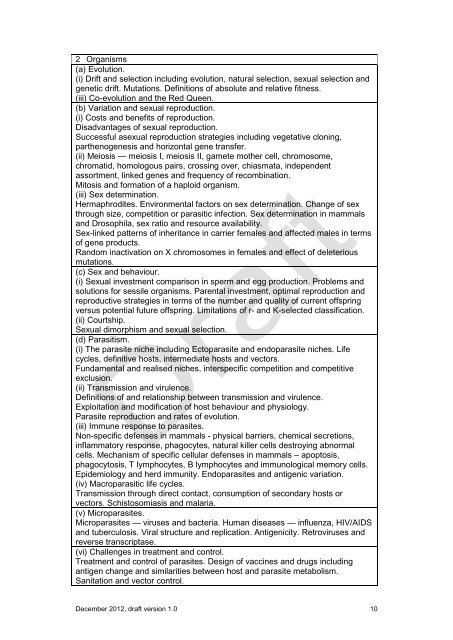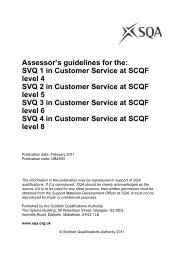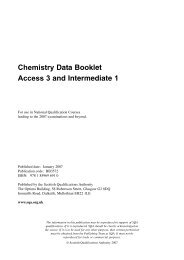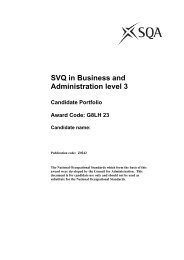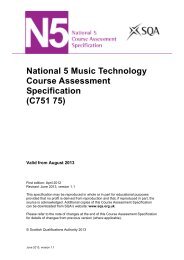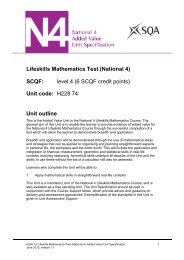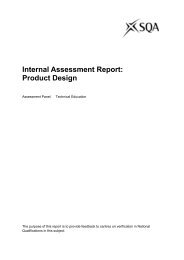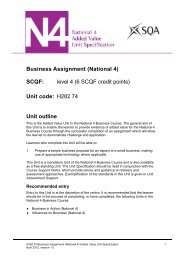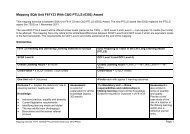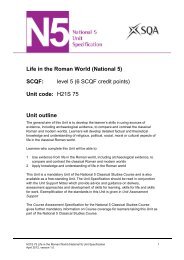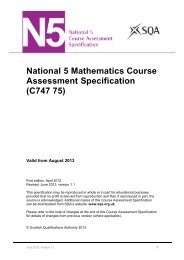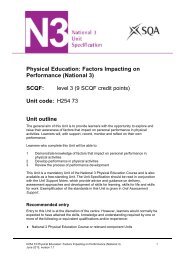Advanced Higher Biology Draft National Course Assessment ...
Advanced Higher Biology Draft National Course Assessment ...
Advanced Higher Biology Draft National Course Assessment ...
You also want an ePaper? Increase the reach of your titles
YUMPU automatically turns print PDFs into web optimized ePapers that Google loves.
2 Organisms<br />
(a) Evolution.<br />
(i) Drift and selection including evolution, natural selection, sexual selection and<br />
genetic drift. Mutations. Definitions of absolute and relative fitness.<br />
(iii) Co-evolution and the Red Queen.<br />
(b) Variation and sexual reproduction.<br />
(i) Costs and benefits of reproduction.<br />
Disadvantages of sexual reproduction.<br />
Successful asexual reproduction strategies including vegetative cloning,<br />
parthenogenesis and horizontal gene transfer.<br />
(ii) Meiosis — meiosis I, meiosis II, gamete mother cell, chromosome,<br />
chromatid, homologous pairs, crossing over, chiasmata, independent<br />
assortment, linked genes and frequency of recombination.<br />
Mitosis and formation of a haploid organism.<br />
(iii) Sex determination.<br />
Hermaphrodites. Environmental factors on sex determination. Change of sex<br />
through size, competition or parasitic infection. Sex determination in mammals<br />
and Drosophila, sex ratio and resource availability.<br />
Sex-linked patterns of inheritance in carrier females and affected males in terms<br />
of gene products.<br />
Random inactivation on X chromosomes in females and effect of deleterious<br />
mutations.<br />
(c) Sex and behaviour.<br />
(i) Sexual investment comparison in sperm and egg production. Problems and<br />
solutions for sessile organisms. Parental investment, optimal reproduction and<br />
reproductive strategies in terms of the number and quality of current offspring<br />
versus potential future offspring. Limitations of r- and K-selected classification.<br />
(ii) Courtship.<br />
Sexual dimorphism and sexual selection.<br />
(d) Parasitism.<br />
(i) The parasite niche including Ectoparasite and endoparasite niches. Life<br />
cycles, definitive hosts, intermediate hosts and vectors.<br />
Fundamental and realised niches, interspecific competition and competitive<br />
exclusion.<br />
(ii) Transmission and virulence.<br />
Definitions of and relationship between transmission and virulence.<br />
Exploitation and modification of host behaviour and physiology.<br />
Parasite reproduction and rates of evolution.<br />
(iii) Immune response to parasites.<br />
Non-specific defenses in mammals - physical barriers, chemical secretions,<br />
inflammatory response, phagocytes, natural killer cells destroying abnormal<br />
cells. Mechanism of specific cellular defenses in mammals – apoptosis,<br />
phagocytosis, T lymphocytes, B lymphocytes and immunological memory cells.<br />
Epidemiology and herd immunity. Endoparasites and antigenic variation.<br />
(iv) Macroparasitic life cycles.<br />
Transmission through direct contact, consumption of secondary hosts or<br />
vectors. Schistosomiasis and malaria.<br />
(v) Microparasites.<br />
Microparasites — viruses and bacteria. Human diseases — influenza, HIV/AIDS<br />
and tuberculosis. Viral structure and replication. Antigenicity. Retroviruses and<br />
reverse transcriptase.<br />
(vi) Challenges in treatment and control.<br />
Treatment and control of parasites. Design of vaccines and drugs including<br />
antigen change and similarities between host and parasite metabolism.<br />
Sanitation and vector control.<br />
December 2012, draft version 1.0 10


